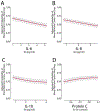Systemic inflammation and delirium during critical illness
- PMID: 38647548
- PMCID: PMC12416785
- DOI: 10.1007/s00134-024-07388-6
Systemic inflammation and delirium during critical illness
Abstract
Purpose: The purpose of this study was to determine associations between markers of inflammation and endogenous anticoagulant activity with delirium and coma during critical illness.
Methods: In this prospective cohort study, we enrolled adults with respiratory failure and/or shock treated in medical or surgical intensive care units (ICUs) at 5 centers. Twice per day in the ICU, and daily thereafter, we assessed mental status using the Richmond Agitation Sedation Scale (RASS) and the Confusion Assessment Method-Intensive Care Unit (CAM-ICU). We collected blood samples on study days 1, 3, and 5, measuring levels of C-reactive protein (CRP), interferon gamma (IFN-γ), interleukin (IL)-1 beta (IL-1β), IL-6, IL-8, IL-10, IL-12, matrix metalloproteinase-9 (MMP-9), tumor necrosis factor-alpha (TNF-α), tumor necrosis factor receptor 1 (TNFR1), and protein C using validated protocols. We used multinomial logistic regression to analyze associations between biomarkers and the odds of delirium or coma versus normal mental status the following day, adjusting for age, sepsis, Sequential Organ Failure Assessment (SOFA), study day, corticosteroids, and sedatives.
Results: Among 991 participants with a median age (interquartile range, IQR) of 62 [53-72] years and enrollment SOFA of 9 [7-11], higher concentrations of IL-6 (odds ratio [OR] [95% CI]: 1.8 [1.4-2.3]), IL-8 (1.3 [1.1-1.5]), IL-10 (1.5 [1.2-1.8]), TNF-α (1.2 [1.0-1.4]), and TNFR1 (1.3 [1.1-1.6]) and lower concentrations of protein C (0.7 [0.6-0.8])) were associated with delirium the following day. Higher concentrations of CRP (1.4 [1.1-1.7]), IFN-γ (1.3 [1.1-1.5]), IL-6 (2.3 [1.8-3.0]), IL-8 (1.8 [1.4-2.3]), and IL-10 (1.5 [1.2-2.0]) and lower concentrations of protein C (0.6 [0.5-0.8]) were associated with coma the following day. IL-1β, IL-12, and MMP-9 were not associated with mental status.
Conclusion: Markers of inflammation and possibly endogenous anticoagulant activity are associated with delirium and coma during critical illness.
Keywords: Coma; Critical illness; Delirium; Inflammation.
© 2024. Springer-Verlag GmbH Germany, part of Springer Nature.
Conflict of interest statement
Conflicts of Interest
Dr. Hughes is a consultant for Sedana Medical and has received research grant from Kohler Chemie GMBH. Dr. Pandharipande has received a research grant from Hospira. Dr. Ely has received research grants and/or honoraria from Hospira, Orion, Pfizer, Abbott, and Kohler Chemie GMBH. The remaining authors declare no competing interests.
Figures



References
-
- American Psychiatric Association., American Psychiatric Association. DSM-5 Task Force. (2013) Diagnostic and statistical manual of mental disorders : DSM-5. American Psychiatric Association, Washington, D.C.
-
- Brummel NE, Girard TD, (2019) Delirium in the critically ill patient. Handb Clin Neurol 167: 357–375 - PubMed
-
- Pandharipande PP, Girard TD, Jackson JC, Morandi A, Thompson JL, Pun BT, Brummel NE, Hughes CG, Vasilevskis EE, Shintani AK, Moons KG, Geevarghese SK, Canonico A, Hopkins RO, Bernard GR, Dittus RS, Ely EW, Investigators B-IS, (2013) Long-term cognitive impairment after critical illness. N Engl J Med 369: 1306–1316 - PMC - PubMed
Publication types
MeSH terms
Substances
Grants and funding
LinkOut - more resources
Full Text Sources
Medical
Research Materials
Miscellaneous

